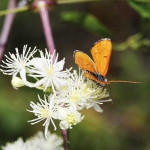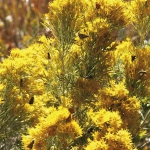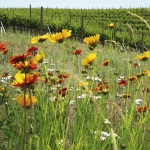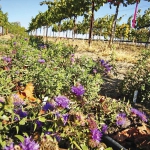Research entomologist Dr. David James spent several years learning which native plants attract beneficial insects to vineyards. Now, armed with a plant list, he’s ready to encourage Washington State grape growers to bring diversity and beneficial insects to their vineyards.
His plant list is still being fine-tuned due to the large amount of data -generated from his three-year research project. But he’s anxious to get information to Washington State wine grape growers, an industry interested in reducing pesticide use, restoring and conserving beneficial insect habitat, and bringing biodiversity back to monoculture farming.
The list identifies which plant species native to eastern Washington are best for attracting beneficial insects, including predators and -parasitoids, to wine grape vineyards.
In his research, James, of Washington State University, studied the pest dynamics of eight vineyards (four conventional and four with restored habitat) in four locations and investigated perennial flowering plants for attractiveness to beneficial insects and their practicality as ground covers and refugia in vineyards.
The four vineyards were located in Red Mountain, Quincy, Columbia Gorge, and Walla Walla Valley. More than 1,500 traps per season were used to evaluate insect attractiveness of some 120 plant species.
“After three years, we now know that native habitat restoration will improve pest management by enhancing biological control and knowing which flowering plants are the best ones in attracting beneficial insects,” he said. The study also evaluated native plants for attractiveness to pollinators (honeybees, native bees, and butterflies).
But he added there is much more work to do.
“We need to expand our database by having more growers plant native species in larger vineyard blocks and in more locations in the state,” said James. “We also need to determine if high-ranking flowering plants are attractive when not flowering and develop native plant ground covers that are agronomically suitable and enhance -biological control. And we need to get the word out.”
There are two aspects of refugia, he explained. One is around the vineyards as a harbor for beneficials, but there’s also the use of refugia as ground cover within the vineyard.
A ground cover, once established, shouldn’t need in-row watering because it’s a native species adapted to the desert environment. But plants must be robust, low growing, and able to stand up to abuse from tractors.
Beauty with benefits
In all four vineyard sites with restored habitat, James found significantly higher numbers of beneficial insects than in nearby conventional vineyards and that fewer sprays were needed to manage pests.
About 50 flowering plant species were in the vicinity of the restored-habitat vineyards compared with approximately ten in the conventional vineyards. The restored-habitat vineyard sites were chosen because the growers had planted native species that were already established before James started the project. The restored and -conventional vineyards were within a mile of each other.
As an example of the pest management differences, in the Columbia Gorge trial, the restored-habitat vineyard had no insecticide applications last year compared with three in the nearby conventional vineyard.
In another site, the Quincy restored-habitat vineyard came close to having a leafhopper issue, but the grower didn’t spray, and Anagrus parasitoid wasps took care of the -leafhoppers.
Though James is still analyzing data from the project, he has put together an initial list of recommended flowering plant species that attract beneficial insects and mites (see “Top ten native plants”).
Most of the beneficial insects that were attracted are generalists that feed on “everything,” he said, but as he further analyzes data, he will be able to identify plants that attract -specific beneficials that are important.
Expand research
A key next step in the study is to expand the project to larger commercial vineyards and more locations within the state.
Five plant species were planted as in-row ground covers in WSU’s research vineyard last year to learn more about the potential of using native plants as ground covers to bring beneficials inside the vineyard.
The state’s largest wine grape producer, Ste. Michelle Wine Estates, in collaboration with James, is also setting up research trials with native plants in four vineyard sites to monitor beneficial impacts. Additionally, an educational garden will be planted at WSU’s new Wine Science Center to showcase native plant species and sustainable -viticulture.
James is presenting his data this summer to Walla Walla Valley wine grape growers during a workshop sponsored by Vinea, the Winegrowers Sustainable Trust. The $250,000 project was funded by Western Sustainable Agriculture Research and Education, Northwest Center for Small Fruits, and the Wine Advisory Committee, the research arm of the Washington Wine Commission.
He credits Walla Walla Valley wine grape growers with giving him the idea for the research and noted that several Walla Walla grape growers began doing this on their own ten years ago. “They had no idea what to plant or which ones would attract beneficials, but they wanted to do something to bring diversity back to the vineyard.”
The concept is getting traction within the industry and gaining the interest of commercial growers, James said. “As growers experiment on their own, we’d like to be included in such trials so we can monitor the plots and add to our database. That’s what we’re lacking—data from whole blocks of commercial vineyards.”
Thus far, research has been in small plots. There’s concern the plot size could be obscuring differences. “The plots are so small that by the end of the season, the beneficial insects may be getting into our control plots.
We need whole blocks so that we can compare to the neighbor down the road who’s not using native plants and develop meaningful data.”
Washington grape growers are fortunate, he said, in having so few pest problems compared to other locations in the United States. “Growers couldn’t do this very well in California because they have key pests,” James said. “We have so few pests here, although we do have virus threat from grape mealybug. But we should promote our low pesticide-input viticulture status more than we do.”
In the works is a WSU manual on native plants and their attractiveness to beneficial insects and their role in enhancing and sustaining integrated pest management in grapes.
Top ten native plants
About 60 plant species out of 120 studied by Washington State University’s Dr. David James attract beneficial insects and have potential as ground cover or refugia plants for vineyards in eastern Washington.
“Surprisingly, sagebrush is at the top of the list based on the mean number of beneficials attracted,” he said. But he calls sagebrush an unbalanced choice because it has a narrow attraction to mostly parasitic wasps. He’s working to fine-tune the plant list to identify those that attract a diverse range of beneficials instead of just a few types.
His top ten list, based on preliminary data of all beneficials attracted, include the following:
1. Big sagebrush (Artemesia tridentata)—attracts the greatest number of individual beneficials, though mostly parasitic wasps and predatory bugs. May be important overwintering resource.
2. Gray rabbitbrush (Ericameria nauseosa)—attracts large numbers and a wide range of beneficials (bugs, thrips, parasitic wasps, and bees). Fall flowering, overwintering resource plant.
3. Western clematis (Clematis ligusticifolia)—attracts large numbers and a wide range of beneficials. Summer flowering, refugia plant.
4. Native buckwheats (Eriogonum spp)—attracts large numbers and a wide range of beneficials. Some are highly drought tolerant, mostly low growing. Ten species show potential. Summer and fall flowering.
5. Yarrow (Achillea millifolium)—attracts large numbers and a wide range of beneficials. Summer flowering, ground cover. Readily available. Hardy plant.
6. Coyote mint (Monardella odoratissima)—attracts a range of beneficials. Potential as ground cover if plant stays low enough.
7. Goldenrod (Solidago canadensis)—attracts a wide range of beneficials.
8. Showy milkweed (Asclepias speciosa)—attracts large numbers and a wide range of beneficials.
9. Stinging nettles (Urtica dioica)—attracts large numbers of beneficials and butterflies. Possibility as a ground cover, though may require more soil moisture than typical in eastern Washington vineyards.
10. Dog rose or Woods’ rose (Rosa canina, Rosa woodsii)—Good overwintering plants but beneficials also attracted to flowers.
Native plants are usually sourced from nurseries as “plugs” and cost in the $2 to $3 range for a plug. Several nurseries specialize in native plant species, such as Derby Canyon Natives, owned by Ted Alway of Peshastin, Washington.
If the right plants are chosen, they should require little water and take care of themselves once established. “The cost is in establishing the plant,” he said, noting that if the right plant is chosen, there should be little upkeep. “It’s a one-off, one- time cost.”
Growers may be able to receive some funds to help offset planting costs by tapping into local conservation district or U.S. Department of Agriculture programs that help fund wildlife/habitat restoration. —M. Hansen









Dog rose, Rosa canina, is not a US native and is an invasive plant in the Pacific and Inland Northwest!